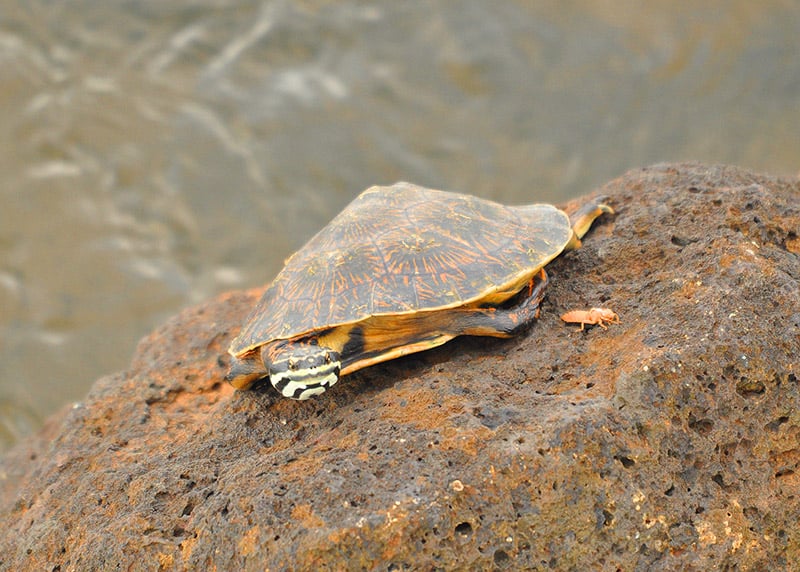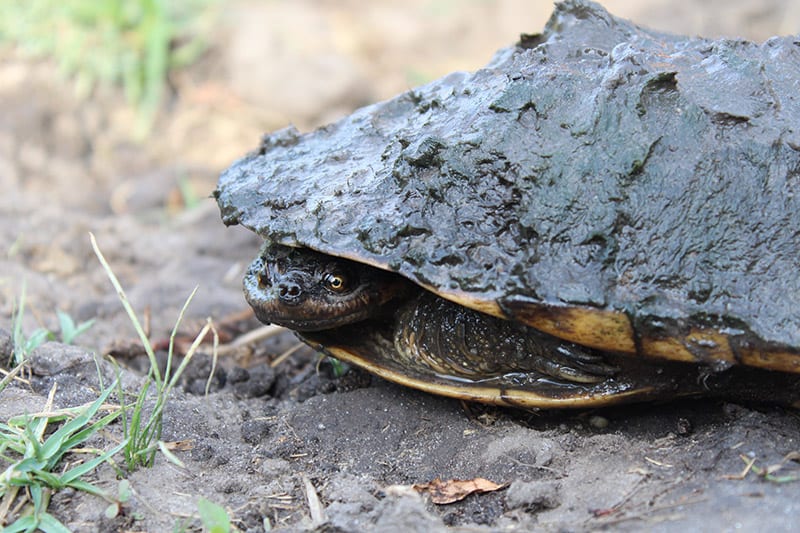Native to South America, the elegant and secretive Argentine Snake-necked Turtle is an exciting arrival for turtle enthusiasts!
Thanks to recent importations from Paraguay and Uruguay, a variety of interesting species of reptiles have arrived in the hobby. Among these is the Argentine Snake-necked Turtle. It is one of the most unusual and amazing aquatic turtles in the Americas. Though a delicate captive, this turtle has been successfully established by keepers offering it the proper captive environment.
Snake-necked turtles are good captives as long as their needs of a proper diet and a proper environment can be provided. They are not baskers. If you see the Argentine Snake-necked Turtle on land, it may be there to explore or dry out a bit or it may be on land because it is being bullied by another cage mate or has a shell problem. This is a very shy species and its enclosure should offer live aquatic plants, submerged bark, and other types of hiding spots.
- For more information see: Selecting and Caring for Your Turtle or Tortoise
Scientific Classification
| Kingdom: | Animalia |
| Phylum: | Chordata |
| Class: | Reptilia |
| Order: | Testudines |
| Family: | Chelidae |
| Genus: | Hydromedusa |
| Species: | tectifera |
Distribution
The Argentine Snake-necked Turtle Hydromedusa tectifera was described by Cope in 1869. They are found in Argentina, Uruguay, and southeastern Brazil.
This turtle is one of the two South American Snake-necked Turtles in the Hydromedusa genus, both of which (as their name indicates) are found in South American. The other is the Brazilian Snake-necked Turtle Hydromedusa maximiliani.
Status
These turtles are not listed on the IUCN Red List.
Description
As implied by the name ‘Hydromedusa’, the Argentine Snake-necked Turtle is one of the most unusual and amazing aquatic turtles. It is flattened and has a wonderful mahogany-looking carapace that is covered with grooves and peaks. The head is striped with a light, almost white stripe bordered in gray or black. They have long, twisting necks, perfectly adapted for snagging swimming fish and grabbing worms and aquatic insects. These are relatively small turtles with adults only reaching 10″ to 12″ (30 cm).
Care and Feeding
All initial attempts to get imported South American Snake-necked Turtles to feed on commercial pellets failed. In addition, many of the turtles seemed dangerously light. However after 2-3 months of feeding on live fish and earthworms, some of the less shy specimens began feeding on elongated commercial pellets (Reptomin® floating sticks). These pellets apparently looked enough like small worms. From here they were soon switched over to other varieties of pelleted food. These shy turtles now eagerly consume a variety of commercial turtle food but are still offered live fish and worms to supplement their diets.

Environment
Imported South American Snake-necked Turtles do best when established in a quiet large enclosure with lots of driftwood and floating aquatic plants. A pair of snake-necks can be set up in a 75-gallon to 100-gallon aquarium. Covering the sides with paper will make the turtles feel more secure.
These turtles require a low pH in the 5.0 to 5.5 range. Establish an efficient filtration system and add peat or sphagnum to the pre-filter or filter, or simply add a large clump in a cloth bag into their water. Some keepers will submerge oak limbs and handfuls of leaves raked from the yard into their South American turtles’ enclosures. This increases the tannins which stain the water the color of tea, but this very closely matches the natural environment of these turtles.
As imported specimens have a tendency to be very nervous, lots of submerged hiding places and plants will help establish this species in its new environment.
Handling
Captive-hatched specimens, as always, are the best to keep as pets and most will become so docile that they can easily be fed by hand. These and all aquatic turtles should be considered wonderful display animals and not pets that are easily held.
Breeding
Little is currently published about the courtship and breeding of Hydromedusa. They have, however, been bred in outdoor ponds by keepers in their country of origin and should prove to be straightforward to breed in captivity once acclimated to their new environments. Two males and three females should be a successful group to establish and breed.
The Argentine Snake-necked Turtles occur in areas where they hibernate during a short, cool winter. Allow them to hibernate in tubs of damp sphagnum moss, mulch, and soil in the 50{deg} to 60{deg} F (10{deg} to 16{deg} C) range for 45 to 60 days. After this time, begin a slow warming up of their habitat to 80{deg} to 90{deg} F (27{deg} to 32{deg} C) and a water temperature of 78{deg} to 82{deg} F (26{deg} to 28{deg} C), and offer them plenty of food.
Rain can be a powerful trigger for courtship and mating in animals found in many of these areas of South America. A period of rain each spring afternoon can be accomplished with a water sprinkler and a simple timer. There are anecdotal stories of Hydromedusa eggs hatching successfully after extended periods of time in the water (Fabius, pers. com.).
Hatchling Hydromedusa are truly stunning babies with crisp, detailed patterns and beautiful red and black plastral markings. They are also very nervous babies. They can be set up comfortably in a 20-gallon long aquarium. An undertank heating pad and a low-watt bulb suspended overhead should provide the correct amount of heat including water at 78{deg} to 80{deg} F and a basking hot spot of 90{deg} F. The addition of plenty of aquatic plants will help immensely in keeping these turtles successfully. Add some guppies and mosquito larvae (if available). They also enjoy eating small redworms and blackworms.
Ailments / Health Problems
Wild-collected Argentine Snake-necked Turtles will often arrive parasitized with roundworms. They will clean up with three to four treatments of Panacur®, but it is best to let these extremely nervous turtles acclimate and begin feeding well before treating them. The added stress of handling and poking and prodding them will no doubt cause more problems initially than the good deed you are attempting.
Captive snake-necked turtles will develop a variety of shell scrapes and injuries to their feet and tails if there are sharp or rough objects in their enclosures. They are especially prone to shell rot and many keepers feel that this affliction is the primary cause for their poor performance in captivity. With warmth and clean, filtered, low pH water, all but the most severe cases of shell rot will clear up within a few weeks. For more severe cases of shell rot and respiratory problems, you can use Baytril® and Floxin® and have very good results.
Availability
Argentine Snake-necked Turtles are occasionally available though fairly expensive, from a variety of sources such as better pet stores, breeders at the larger reptile shows across the country, and on-line.
Featured Image Credit: Alan Jimenez G, Shutterstock
